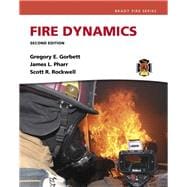Improve readers’ understanding of fire dynamics with real-world insight and research
Written to the FESHE baccalaureate curriculum for the Fire Dynamics course, Fire Dynamics offers a comprehensive approach to fire dynamics that integrates the latest research and real experiments from the field. The Second Edition’s all-new design makes locating information even easier for the reader. With twelve chapters and FESHE and NFPA references and guidelines throughout, this book is a useful resource for all fire service professionals–from the student to the fire investigator.










